Spatial Audio M3 Triode Master + interview with designer Clayton Shaw
Aki Mäkivirta, director of research and development at Genelec, said in a recent interview in Audio Media International, “We never use DSP to correct for bad transducer design, but only to enhance the overall system performance.” The same can be said for Clayton Shaw and his approach to loudspeaker design. Though the company he was long associated with, Emerald Physics, routinely reaches for DSP to tame untoward behaviors, at his current gig Spatial Audio, Shaw makes strategic design choices that ensure good behavior. Only his high end X1 Uniwave and top of the line Lumina include active electronics. His M3 Triode Master, a 12 Ω open baffle (OB) model, has nary an active anything in sight.
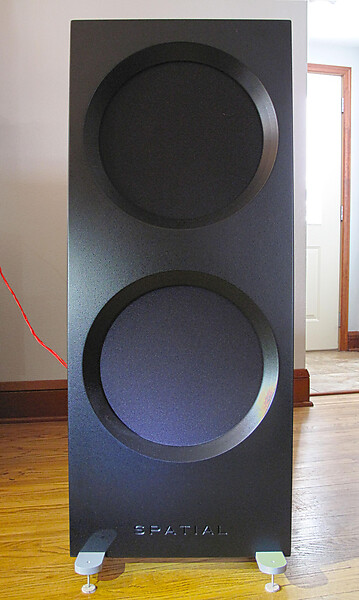
Spatial Audio’s M3 Triode Master
Spatial Audio’s $3995 M3 Triode Master, henceforth “M3TM,” combines two 15″ mid/woofers with one of Spatial’s M35 dipolar compression drivers. Wait, dipolar what what? To improve dispersion and increase the sense of envelopment, the M3TM incorporates a 15″ paper cone direct radiator with a coaxial, horn loaded 1″ throat compression driver in place of a dust cap. To sweeten the pot, actually the soundstage, the back side of the compression driver’s diaphragm is exposed toward the rear. With a slight inset taper horn coupling the transducer’s back, the outcome is exceptional forward temporal response from the innovative design, and a wide envelopment thanks to that rear firing outlet. The resulting response is dipolar or, “…more correctly cardioid, since less energy radiates from the rear,” according to Shaw. The 42.5″ x 17″ x 2.5″ baffle is relatively short and narrow, with beveled cutouts for the two big direct radiators. With integral grill cloths to hide the drivers from the front, the ensemble telegraphs a muscular, decidedly modern mid–century visual vibe.
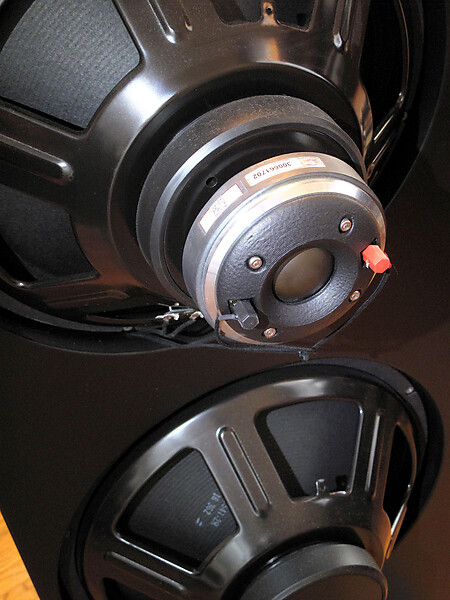
Rear view, showing bass and midrange drivers open to the rear, as well as the compression driver’s exposed diaphragm
As with many open baffles, almost the entire guts of the system is laid bare from the back for easy viewing. An exception is the crossover, which is enclosed in a cavity behind the speaker terminal plate. The spring loaded terminals on the compression driver makes it simple to defeat its contribution. This is not something you want to do a second time once the experiment has been made. That cardioid operation mentioned above is essential to elevating this speaker above the ordinary. The lack of “Box,” with a capital B, also makes this product speak with an unencumbered coherence very few acoustic suspension or ported designs can match, especially at the $4k price point.
DSP? Who needs it! Well, I do actually. At least in my room, all it took was a modest 3.2 dB boost from cascaded first order shelves in Amarra Luxe at 43 and 103 Hz to give me all the bottom I’d ever desire. The rest of the audio spectrum was well behaved. I did dial in an additional 1.2 dB of shelf at 4941 kHz to goose the detail a teensy bit. Because open baffles couple to the room better than boxed speakers, the M3TMs weren’t picky about placement either, though the dipole nature meant they were best away from a rear wall. In my case, I ended up with them about 44″ from a rear wall and 6 feet from the listening position, parallel to the walls with no toe in. With that placement, I sensed a big wide soundstage with a cleanly defined phantom center. On the HRA remaster of After Midnight (Qobuz 192k), the old standard Caravan is delivered by Nat Cole’s sultry self right there in my living room.
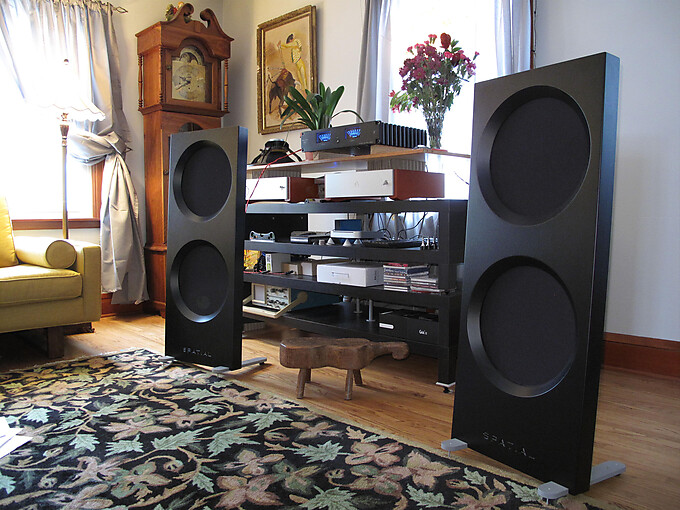
One aspect of the M3s that I was initially unhappy with were the feet. As supplied, the hard plastic footers have threads a skimpy ½” in length that prevent a more raked angle being dialed in. When I mentioned this to Shaw, he told me that feet with longer threads are available, and sent me out a set of 1.5″ spikes that worked well with my thick carpet. I strongly suspect that the GAIA aftermarket isolation stands from IsoAcoustics would also benefit the M3TMs as much as they have for a set of Trio15 open baffles I have in house at present, though I didn’t have an opportunity to try it.
John Reekie, kingpin of HifiZine, had asked me about their bass performance, concerned that OB low end would be lacking. Worry not, dear editor, though if you grew up with Beats headphones and crave the artificially hyped booty so common today, you will find the last octave lacking. Specifically, the M3TMs lack that slam at 30 Hz you get from large box designs. If you must have the big bottom that Kendrick Lamar and E. Power Biggs fans crave, then Shaw has a solution. His M Force provides the extra surface area needed to really move air, see below.
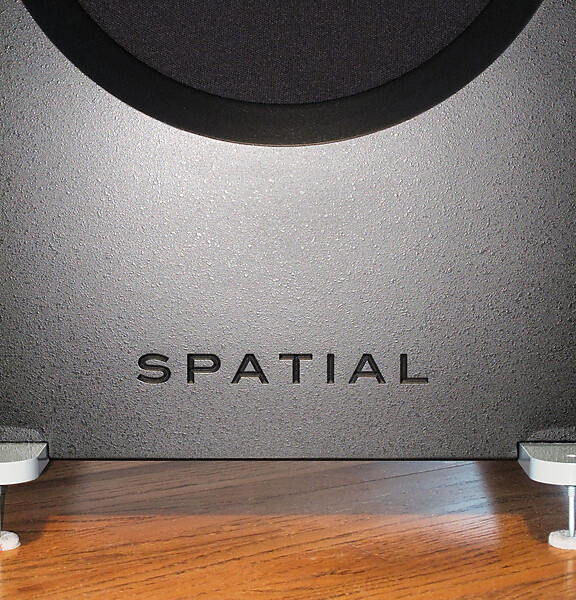
Interview with Clayton Shaw
I had many questions for Clayton, and he was kind enough to take a chunk of time to answer via e–mail. What follows is a lightly edited version of that conversation…
OMas: Tell me about the drivers and their component parts: cone/diaphragm materials, magnets et cetera.
Clayton Shaw: The woofers are designed specifically for (open baffle) applications and are made by Eminence in Kentucky. I wanted a large, short throw, lightweight design since the M3 is a 2-way, and I wanted good dynamics and a live presentation. The cone material is a paper composite with a linen accordion–type surround that is common in pro sound designs. The magnetic structure is ceramic with a vented pole piece.
The compression driver is a high linearity, 1″ exit design with 1.75″ diameter diaphragm. The titanium diaphragm has a nitride coating that increases stiffness in order to raise the first breakup point above the audible range. It also employs a patented front chamber design that improves midrange quality.
OM: Regarding the coax, sourcing that must have been a bit of a bear. Can you share any info?
CS: The woofer section and compression driver section are from different sources. It took a lot of development time, but was not overly challenging in terms of engineering. Most pro audio companies have in–house sample development departments, so it can be quite efficient to develop a driver design. We have been working with Eminence on designs since about 2002.
OM: What prompted you to design the Triode Master? The previous iteration I heard a while back (the M3 Turbo) lacked the rear–facing driver. You’ve not only added that dipole aspect, but also made positive changes to the voicing.
CS: The idea was to max out the M3 platform and eliminate cost–related compromises inherent in the Turbo versions. The main improvement comes from a fully dipolar OB compression driver design, which sounds more spacious and natural. We also incorporated impedance and phase compensation circuitry to allow greater compatibility with tube amps with higher source impedance. Other tweaks include Duelund (Duelund Audio) wiring and premium (ClarityCap) capacitors.
OM: Speaking of amplification, I’ve been driving it with a 40 W (into 8 Ω) Lindell AMPX solid state Class A and a SPEC RPA-W3EX 50W Class D as well as LTA’s ZOTL Ultralinear. The speaker behaves well with all three but you focused on another amp class altogether during design. Please tell me about that.
CS: Yes, we use several amps in development in order to make sure we have good compatibility with a range of designs. The four main amps we test with are LTA ZOTL 40/ LTA Ultralinear, Vinnie Rossi LIO, Pass XA30.8 and Red Dragon S500 Class D amp. They each have their own character and advantages and represent a good range of what amplifiers our customers own.
OM: Tell me about the M4 Triode Master and your M FORCE…
CS: The M4 Triode Master is the same speaker as the M3 TM but with 12″ diameter mid/woofers instead of 15 inch units. The M-Force is an M3 without compression driver or crossover, to be used as an augmenting OB bass add–on. It comes (bundled) with an outboard sub amplifier.
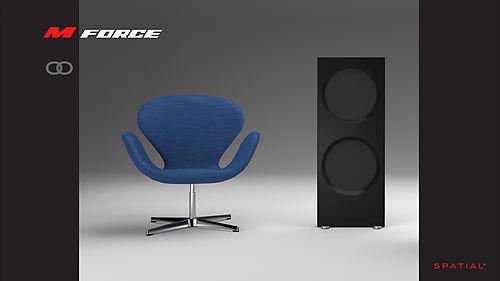
Spatial Audio’s M-Force bass system
OM: For a bit of background on you, can you give me some history on Evett & Shaw, Emerald Physics and any other career antecedents?
CS: I am one of those people fortunate enough to know what I wanted to do very early. I started building speakers to test and learn at around age 13 or 14, which drove my parents crazy. Built the Heathkits and Dynaco ST-70 kits etc. There happened to be an amazing high end audio store on the campus of the University of Oklahoma three blocks from where I lived. The day I walked in the store (The Gramophone), I immediately knew that this was it. I’m standing there looking at all manner of crazy and brilliant products like the Dayton Wright XG VIII, IMF, Dunlap Clark, Levinson, Gale, Transcriptor, Magnepan, Sequerra, Audio Research, etc. Done – this is me!
I decided right then that I would work until I could make my own contribution to the art. I worked there throughout Engineering school and thoroughly enjoyed that phase of my life. I later opened my own store (Audio Dimensions) where we carried Martin Logan, Futterman, Linn/Naim, Fried, Meridian, etc. I sold that business and went to work for the computer hard drive maker Seagate, who had a huge plant in OKC (Oklahoma City). A few years later, we wanted to move west and settled in Salt Lake City in 1990, where my wife did her Masters degree at the U. of Utah. As many have noted, speaker design’s in the water out here for some reason.*1
Throughout the period from 1978 until today, development and testing has been ongoing. Around 1988, I lost interest in box speakers because our OB testing was so promising. It just took a long time to perfect. Around 1997, I went to work in the professional sound industry for a large speaker manufacturer and became exposed to many useful ideas that are not generally seen or considered in home audio, like “Controlled Directivity” and high efficiency, big driver systems. It became very apparent that the way the speaker interacted with the room was being overlooked by home audio designers. Boxes are simply a poor choice for domestic environments because the room boundaries are too close, whereas in an auditorium they work fine.
The best description of my approach is a large studio monitor without the box enclosure. I was fortunate to be Director of Engineering and R&D, so we explored everything you can imagine with a team of six engineers, an anechoic chamber and (Meyer Sound) TEF20 measurement system. All the big pro driver companies like Radian, Eminence, B&C, and Beyma would just send thousands of dollars of drivers continuously, so we tried everything. Eric Alexander (now of Tekton Design) was one of the main R&D engineers and did some very innovative work that we received patents for. That company was eventually absorbed by a larger company, so I decided to move on and prepare my first commercial OB design in 2008, the Emerald Physics CS2, which proved to be very popular and started the transition for OB from being associated with DIY to mainstream acceptance.
The CS2 was a paradigm–shifting product idea. The drawback was it required an outboard DSP processor. When I later started Spatial Audio, the main directive was to achieve at least equivalent sound in a passive, analog speaker. The M3 was a huge hit almost from the beginning in 2015 and we have continued to try to find ways to improve the sound and production. We have just purchased a large industrial CNC router machine and related equipment to allow us to make the complete speaker in-house.
OM: Last item; any suggested reading on open baffles and how they interact differently with a room?
CS: Check out www.linkwitzlab.com for OB room interaction info.
Concluding remarks
That impedance control Clayton mentioned above sure made a difference with one of the amps I had during my time with the M3TMs: Linear Tube Audio’s ZOTL Ultralinear that Shaw mentioned. Lacking an output transformer, that particular amplifier is sensitive to impedance variations with frequency as presented by the load. This was heard with other speakers as easily perceived and unwelcome timbral shifts. The M3 Triode Master, with it’s nicely behaved impedance across the audio spectrum, presented a perfect mate to LTA’s Ultralinear. Combining the ZOTL amp’s touch of hollow state richness with the M3TM’s lush, broad soundstage and resonance-free presentation was a thing of beauty. Though the M3TM doesn’t provide the extended air of, say, PureAudioProject Trio15 Heils I had in house to compare, the M3 Triode Masters offered a convincing soundstage with a subjectively smooth delivery and honest timbre of whatever I threw at them. By the way, Linear Tube Audio is the Spatial distributor for the East Coast of the US, while my friend and neighbor Paul Spelz of ANTICABLES is Spatial’s rep for the northern and midwestern US.
The M3 Triode Master is a outstanding example of OB design; exacting imaging combined with broad uncolored off–axis coverage and an airy, expansive soundstage. Its neutral, linear voice, and narrow depth form factor lends itself nicely to rooms large and small. If you want to give your ears and brain a treat, sit down in front of a pair. You’ll love what you hear… I certainly have.
Manufacturer
Spatial Audio
4220 W 2100 South, Unit L
Salt Lake UT 84120 USA
M3 Triode Master – $3995
Ancillary Equipment
- Source: Amarra Luxe ($99 direct, www.sonicstudio.com/amarra/), Audirvana Plus ($74 direct, www. audirvana.com)
- Conversion: exaSound e22 Mk. II, Mytek Digital Brooklyn
- Amplification: Linear Tube Audio ZOTL Ultralinear ($6800 MSRP, www.lineartubeaudio.com), SPEC CORP RPA-W3EX ($11,500 MSRP, www.spec-corp.co.jp) with H-VC5 controller ($1100 MSRP), Lindell AMPX ($1600 street, www.lindellaudio.se)
- Cabling: VUE Digital VU-3 (USB), Soundstring GEN II Beta 2-22S (XLR), AntiCable Level 3 (speaker), Soundstring GEN II Digimax-18 (power)
In heavy rotation during this review
- Ross from Friends: The Outsiders [TIDAL 44.1] – Deep dub textures
- Daniel Brandt: Eternal Something [TIDAL 44.1] – Insistent rhythms propel this instrumental mix of acoustic and synthetic elements through a complex soundscape
- Johnny Nash: I Can See Clearly Now [TIDAL 44.1] – Always a pleasurable listen, with backing vocals clustered stage left with an extra voice panned center right.
- Ian William Craig: Meaning Turns To Whispers (Bandcamp 2016) – Sometimes prickly ambient that’s perfect for watching the world go by via rail, or while writing equipment reviews!
- Becca Mancari: Good Woman (Gold Tooth Records/Tone Tree Music 2017) – Quiet, contemplative Americana
- Lionel Richie: Can’t Slow Down [TIDAL MQA 96k] – Beautifully recorded antique pop
- Neneh Cherry: Broken Politics [Qobuz 44.1] – Industry vet brews a modern mini–masterpiece
- Hailey Tuck: Junk [Qobuz 44.1] – A jazzy modern vocalist who’s soul was reincarnated from the ’20s
Footnotes
(*1) Editor’s note: This is an American trope meaning that some aspect of human behavior is so prevalent that there must be some mysterious substance in the water that’s causing so many people to manifest that behavior.




Really enjoyed reading this. I own a pair of M3TMs and you describe them very well. I am getting terrific powerful clean bass with punch and thrust. But they will not do justice to the deepest organ pipe on my Naxos Vaughn Williams Symphony Antarctica. Not many speakers can. I may eventually get a very fast high quality subwoofer to go with them and if I do the low frequency cut off will be set quite low. The imaging and sound staging I am getting are first rate and just about as good as anything I have heard and this is with my room’s poor acoustics that are off balance and poor for imaging especially with box speakers. Not at the level of say a pair of Sanders Sound System speakers in the sweet spot but better than many speakers I have heard with a 5 figure price tag. I realized that my classical music collection was exploding with the M3TMs. The tone, imaging, and open staging really makes these acoustically recorded instruments sound natural and more like a live event. This was the main thing I was after when I purchased these speakers and they have delivered.
I, too, have the M3TMs and after 50+ speakers over 50 years these are my favorites. I have had
two Maggies (3.6, and 1.7i), two Vandersteens, two Klipsch, Tannoy, Alone, Audio Physics, Vapor Audio, Clairaudient, and Emerald Physics and nothing beats the M3TMs. The Maggie 1.7i with crossover upgrades was
the closest but the high current amplifiers needed limit amplifier choices. I highly recommend that you find a pair to audition before you buy anything else. I have tried high quality subs with these but the
they actually limit the bass range clarity more than they help.
Hey Mesaman,
That is quite a parade of speakers! 😉 One comment: With open baffle speakers, it’s best to employ an open baffle sub.
I, too, own the Spatial M3 Triode Masters and after owning nearly 40 speakers over 40 years, these
are my favorites. I agree with the review above, that the sound is so clear and coherent that it
just allows the music to come thru. Low is bass is noticeably deficient compared to subwoofer
systems I have had in the past but the quality of bass is the best I have ever had.
I was surprised to hear that this model was not tested using flea powered amplifiers, but I can
state that my 15 watt EL84 integrated works just fine. I have a higher power tube integrated and I
suspect that these speakers can absorb a lot of current if needed. No need to hesitate with solid
state amps. Highly recommended.